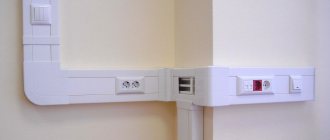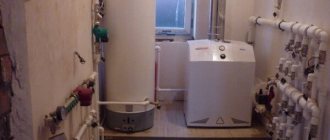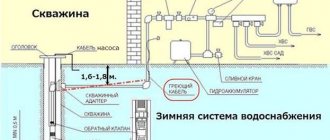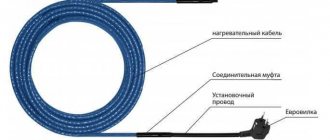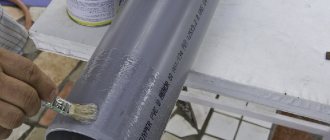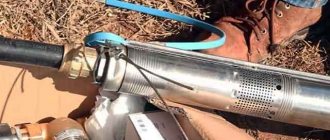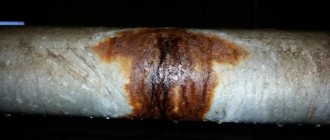Design and methods of application
The technical characteristics of heating cables, their types, differ significantly from each other, and are used for heating:
- Water supply.
- Sewers.
- Drains, tanks.
- Pipelines for various purposes.
With all the variety of tasks assigned to these heating elements, their main purpose was and remains to prevent liquids from freezing by increasing the temperature.
Sergey Yurievich
Construction of houses, extensions, terraces and verandas.
Ask a Question
These heating systems are applicable for communications located outdoors - both in the ground and in the open air.
An important advantage in the operation of these systems is the function that is commonly called zonal application. In other words, you can always assemble a mini-system from a set of elements in order to heat a small area without connecting it to the general network. Benefit:
- Saving materials.
- Energy is saved.
There are elements with a length of 150-20 mm, and windings of 200 m.
Components of such systems:
- Inner vein. There may be one or several. It is made of alloys with high electrical resistance, and the higher it is, the greater the specific heat release.
- Insulation. It is made of polymers. As a rule, a screen made of aluminum or copper is used together with it.
- Outer shell. Very durable, made of PVC - it covers the internal elements.
This is roughly what the heating cable looks like, as they say, in cross-section. This can be seen more clearly in the instructions for this element or on the World Wide Web.
Some nuances are possible - different alloys or insulation methods. It all depends on one manufacturer or another.
In addition, the cables are flat in shape. This is why they are called tape.
To improve the characteristics, the copper braid (screen) is covered with a layer of nickel, and as for the outer layer, it is increased.
Requirements for PVC material: moisture resistance and ultraviolet resistance.
There are also so-called food cables - they are used for internal installation and comply with sanitary standards. Drinking water must be safe for health.
Low voltage analogue
In hazardous (explosive, fire hazardous) industries, there is a need for a low-voltage element - this is required by both the technological process and safety precautions.
Thus, 12-14 volt cables are widely used.
How does a water heating cable work?
Any cable system designed to heat something converts electrical energy into heat. This occurs due to the thermal effect of current in special heating elements - they are special cables.
This fully applies to heating water pipes.
Types of heating cable
Any heating system consists of two categories:
- Resistive. It is preferable to heat short sections of small-section pipes (up to forty mm).
- Self-regulating. Used on long sections of water pipelines. Such cables are also called self-regulating, “samreg”, self-heating, self-heating, smart, etc.
Both of these types have their own scope and are widely used, so it is worth considering both options separately in more detail.
Resistive
The principle of operation of a resistive cable is extremely simple: one or two cores are insulated, and the electric current passing through them heats it up.
A high heat dissipation coefficient is promoted by high resistance and current strength.
There are pieces of this cable on the market of varying lengths, and they have a constant resistance. During operation, any of these cable sections produce the same amount of heat over the entire length.
When installing the system, do not forget that the single-core cable is connected at both ends.
Such contours are most often used to heat roof drains, as well as to install the so-called “warm floor”.
However, this option is also applicable to plumbing.
One core is not suitable for internal installation, since laying the loop takes up a considerable amount of space inside the pipe, and accidentally interrupted elements lead to overheating.
The difference between a two-core cable is that one of the cores is responsible for energy transfer, and the other for heating. Such resistive cables are used for water supply no less than samregi. They are mounted inside the pipe using tees and seals.
The main advantage of such cables:
- Acceptable price.
- Long service life - about 10 or even 15 years.
- Easy to install.
There are also disadvantages:
- The likelihood of overheating due to the intersection or too close “neighborhood” of another cable - you will get a kind of “boiler” of a very long length.
- Fixed length. It cannot be increased, nor can it be decreased - such an attempt will end with the element overheating and not lasting very long.
- A burnt-out section cannot be replaced. In this case, a complete replacement will be necessary.
- The power cannot be adjusted due to its uniformity along the entire length.
In order not to spend money on constant cable operation (expensive), many install thermostats (with a sensor). If the temperature drops below 3°C, the heating is turned on, and if it is more than 7°C, the current is turned off.
Self-regulating
The second type of cable is self-regulating and universal. They can heat:
- Roofing elements.
- Sewer lines.
- Water supply systems.
- Containers with liquid.
This cable is characterized by independent regulation of power, as well as the intensity of heat supply. When the temperature drops below the set value, the cable turns on the heating without anyone's participation.
A conductor tends to increase or decrease current depending on its resistance. If the resistance increases, the current decreases. Because of this, power also decreases.
At the moment of cooling, the resistance drops, and the current strength, on the contrary, increases - as a result, the heating process occurs.
The main advantage of self-regulating cables is that they have zonal operation. The cable independently distributes the heating, thoroughly heating those areas that are cooling down, and controls the optimal temperature where strong heating is not necessary. More benefits:
- This type of cable can be cut into pieces of the desired length.
- There is no need to be afraid of such intersections.
- It is easy to install.
- By heating pipes with a self-regulating cable, simplification of the system design and its calculation is achieved.
- High reliability and long service life.
- Energy is saved.
The price of such a heating element is approximately 25% higher, but it is compensated by the fact that temperature control equipment is not needed.
To fully automate the process of turning on and off such a cable, it is quite reasonable to equip the system with a thermostat that is “tied” to the outside temperature.
Then it turns on only when needed. It works if the water temperature is below 5 degrees, and if the temperature is above 15 degrees, the heating cable is turned off.
This, of course, not only saves energy, but also extends the life of this element. Each meter of said cable consumes an average of 9 to 17 W.
Another nuance (minus) of any system is that a failed cable means the water in the pipe freezes, which makes replacing it additional difficult, since you also have to defrost the pipe.
Comments:
Stepanych
The article is good, but this cable is in no way intended for heated floors. It will not be possible to heat it to any acceptable temperature. For defrosting and anti-icing purposes only. This cable is no longer good for anything.
Worker
Expensive and impractical. I have never met a self-regulating cable that worked normally for at least 2-3 years. Everyone has problems. In general, it’s a crude technology, and very expensive, too.
Leave a comment Cancel reply
Related Posts
Advantages and disadvantages of electric heating radiators
Selecting a heating cable for heating a water pipe
Heating the roof will help avoid problems with melting snow.
Do-it-yourself electric heating of a greenhouse with a cable
How to connect a heating cable: installation methods
There are, as already mentioned, two ways to install a heating cable on a water supply system:
- Interior. The element is inserted inside.
- Outer. The cable is fastened by winding along the pipe.
The thermal cable connection should be made strictly following the attached instructions (diagram).
Inside the pipe
This method is not suitable for every pipe. Its cross-section must be at least 40 mm. If you deviate from this rule, then in small-diameter pipes the heating element will partially block the flow of water.
It will be difficult to arrange heating for a long pipe in this way, but for short sections this option is the most rational way.
In vertical areas, it is most convenient to lay this element from top to bottom. The process takes place using a sealing sleeve and a tee - the first prevents the cord from slipping.
Such installation is often more expedient than external installation, due to repair or replacement of elements. Everything is simpler here - take out the old one and start the new one. In this case, during pipe laying, measures must be taken to quickly replace the cable - many craftsmen first install it without corners and couplings - the pipe is simply bent smoothly. This way the cable can be easily removed and a new one can be easily inserted if necessary.
There is another method when two cables are laid in the pipe, one of which is connected, and the other is kept in reserve, not energized. So, if the first cable fails, another, working one is used, and no excavation work or other “excavation” is required. The disadvantage of this method is that it is quite expensive, and not every homeowner agrees to it.
Outdoor installation
Winding an element outside the pipe is characterized by the fact that this method is not very reliable and convenient in the sense that if the element fails, it will have to be dug up, and this is very labor-intensive and difficult (depending also on where and how it is buried). The time of year plays a big role when, due to freezing of the soil, this will be almost impossible to do.
As for the actual external installation, it is easy to do it along the pipe. Step by step:
- The heating element is fixed at one edge using self-adhesive fiberglass or plastic clamps that can withstand high temperatures.
- The fastening step of the holders is 30 cm. Metal fastenings are not used!
- The length of the heating element is equal to the length of the pipe that will be heated.
This is how the so-called linear installation is carried out, which exists in addition to spiral installation, in which the cable is wound along its entire length. It is especially relevant if the pipes are buried in the ground.
In the first case, the heater is mounted not from below or from above, but in the “8 o’clock” or “4 o’clock” position.
Wind the cable onto pipes of medium or large diameter, in measured steps. The advantages of the winding method are that the contact is maximum and so is the heating. The disadvantage is the increased consumption of material, in contrast to the linear method.
How to install
Insulating the water supply system is a difficult task, but one that cannot be delayed. A heating cable is used for this purpose. The temperature of the cable heating can be changed by varying the resistance value of the device. The heating cable can be installed both inside the pipe and outside. In any case, it is selected in such a way that the heat loss of the water supply network does not exceed the amount of heat generated by the system.
The cable can be laid in parallel rows or in a spiral. Fastening is provided by a tightening metal mesh or adhesive tape. To better retain heat outside, the pipe with the heating cable is wrapped in foil. The task of installing a heating cable, of course, is best handled by specialists.
How and with what to insulate
The absence of a basement floor especially forces you to take care of insulation.
Pipes, of course, can be partially buried in the ground, but some part of them will inevitably come out, and it requires thermal insulation. In the first case, the depth to which the pipe was buried plays an important role - it is not always possible or even the desire to dig a hole or trench to the depth of soil freezing - after all, in Siberia and the North this value is several meters.
If the house is located on a slope, then the space under it is quite large; wind and frost “walk” there, even if this gap is covered with some kind of shield material. The mentioned gap can reach one meter or even more, and here we need effective measures to protect the pipes from the cold.
Insulation can be different, and the most common is packing pipes with mineral wool. But this coat is not always effective, and such measures are not always sufficient.
For insulation of wells, for example, extruded polystyrene foam is sometimes used. The method is very labor-intensive, since it requires a whole set (package) of pieces of this material and you also need to make holes in each of them for the pipe. This entire “structure” is buried in the ground (if possible). This material, by the way, is not cheap at all.
Not just a cable
Whatever the type of cable used, insulation is still carried out - this is much more reliable, especially considering that the cable will eventually fail, and the water in the pipe will freeze in a short time.
Thermal insulation is installed over the water pipe and cable. If, however, the pipe and cable are not packaged in this way, then the heating will be wasted almost in vain - into the atmosphere.
In addition to the already mentioned polystyrene foam, foamed polyethylene is also used. Both of these materials are moisture resistant and provide some protective cushioning for the pipes. Although they themselves also need additional protection.
For this simple reason, the well-known design “pipe in pipe” is very often used, especially if the pipes are placed in the ground or in the air. The insulation is located between these pipes - between the “standard” and the protective one, it is of a larger diameter, taking into account the thickness of the thermal protection.
Useful tips
It is very difficult to navigate the sea of heating cables offered on the modern market - there are too many offers from different manufacturers. What you need to know and consider:
- Before going to the store, you need to know exactly the diameter of the heated pipe and the length of the area protected from the cold.
- At the same time, you still need to focus on the lowest temperatures to which the soil or air can cool.
- It is necessary to clarify the presence of a protective braid, which increases the reliability of the heating element and provides grounding.
- The following is also important: type of external insulation, power, temperature class, as well as the manufacturing company.
External insulation type
If a polyolefin-insulated cable is suitable for sewer pipes, then fluoroplastic protection is better suited for internal installation (directly into the pipe). Fluoropolymer is also quite suitable for outdoor installation - it protects from both moisture and ultraviolet radiation.
Temperature and power
The medium temperature system is suitable for larger diameter pipelines. The maximum system temperature is 120°C. The power reaches up to 33 W per meter.
The most powerful are with a temperature of 190°C, their power is already 95 W per meter. Such systems are not used in everyday life; their scope of application is industry.
You can select and correctly calculate the optimal power based on the diameter of the pipe. Examples:
- For water supply systems with pipes up to 25 mm in diameter, cables with a power of 10 W per meter are used.
- From 25 to 40 mm – 16 W per meter.
- From 40 to 60 mm - 24 W per meter, etc.
Recommended Manufacturers
There are brands of heating elements that have proven themselves to be long-term, stable and reliable. Imported products:
- Lavita.
- Nelson.
- Ensto.
- Devi.
- Raychem.
The most popular Russian manufacturer is considered to be the company Teplolux (SST), which specializes in high-quality household products.
Homemade heating cable
Nothing is impossible, and you can also make a heating cable with your own hands. There is enough information on this topic on the Internet in the form of:
- Videos.
- Schemes.
- Articles.
Having some skills in basic electronics, as well as the desire to produce one, using an on-board computer, a power supply, and some materials, many craftsmen make effective, reliable and safe systems for such heating.
The most common reason for making homemade products is the desire to save money, and such “craftsmen” often use “mongrel” wires instead of cables. So, when creating something like this, you need to think a hundred times before doing something that could ultimately lead to a short circuit, even a fire. In addition, everything related to drinking water requires a special, thoughtful attitude.
You can make homemade automation if you have experience in this matter, but it’s not worth experimenting with wires at all - it will end up being more expensive.
They say that the greedy pays twice - but that’s not so bad, it’s worse when such a makeshift device harms your own health and the health of your household. Not to mention the safety of the home itself and the breakdown of the water supply due to defrosting.
Reviews
There are plenty of reviews on the Internet about heating cables. Users use them to heat the following communications and surfaces:
- Drainage.
- Drainage devices.
- Water pipes.
- Sections of pipes in an artesian well.
- Sewage systems, etc.
Opinions are divided. Some claim that this method of electric heating is simply irreplaceable, while others claim that a deep trench for pipes will work “cheaply and forever.”
Users of devices such as heating cables assure that with a thermostat, heating is more profitable and saves electricity.
In addition, many are inclined to believe that the combined option is still more profitable: the pipe is buried in the ground and heated by a heating element.
It is strongly recommended not to wrap pipes located in the ground with mineral wool - they absorb moisture. This is how the insulation becomes useless, and the risk of freezing is present.
Everything, apparently, depends more on the specific situation and financial situation of the homeowner.
Installation of heating cable
In most cases, installing a heating cable is not difficult and anyone can easily handle it, even if they have no experience. The installation method depends on the specific tasks; let’s look at the example of pipes (where heating cables are most often used).
The cable can be pulled outside the pipe; this is one of the simplest options. It can be stretched lengthwise and straight, or in the form of a spiral, which will require a longer cable, but will provide better heating. The top is wrapped with thermal insulation, which can even be ordinary foil, which reflects heat. Of course, this method is simple only if the pipe is just to be laid or it is laid outside (not in the ground). And if the pipe is already dug into the ground, then you will have to dig it up, or use the second method.
You can also extend the cable inside the pipe. In this case, there are both pros and cons. The heating efficiency will be higher, in addition, you can run the cable in an already installed pipe. However, the throughput of the pipe will decrease, and in certain cases this can be very important. Difficulties may also arise if the pipe is very long; here, without special devices, it will be very difficult to stretch the cable. But if the pipe is short, then there will be no difficulties with installing the heating cable. All other things being equal, it is optimal to choose the option inside the pipe.
